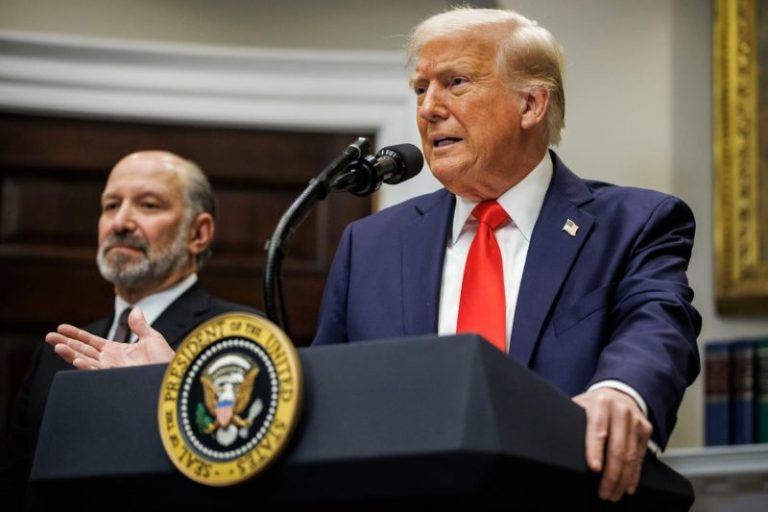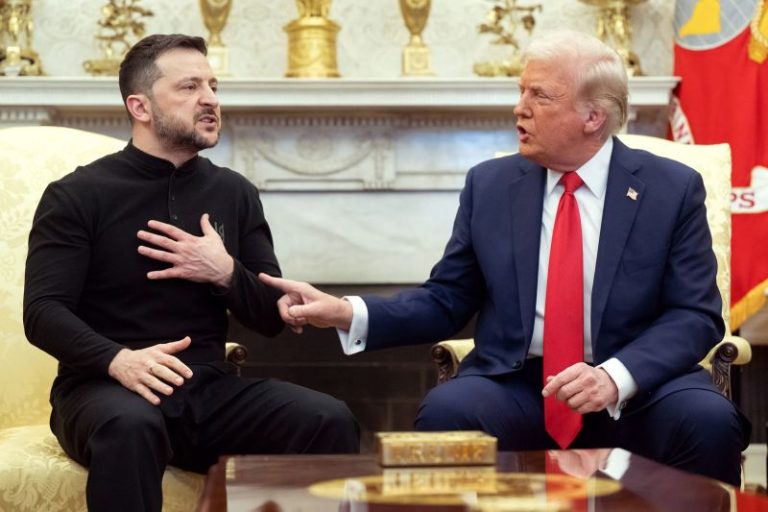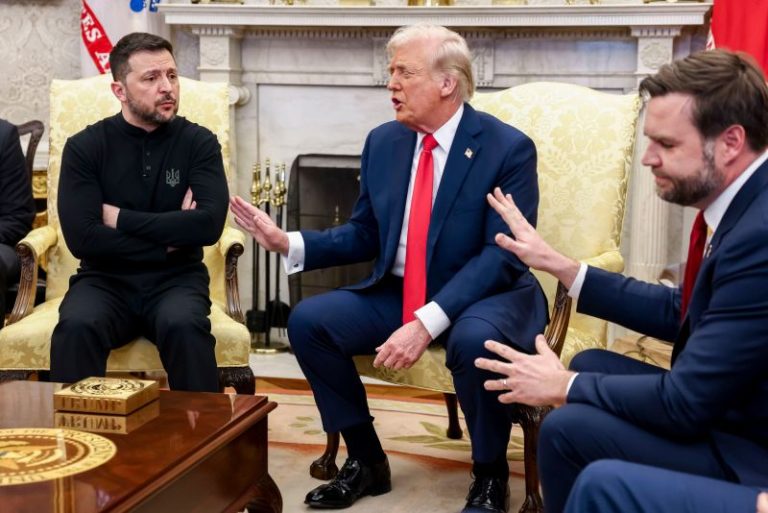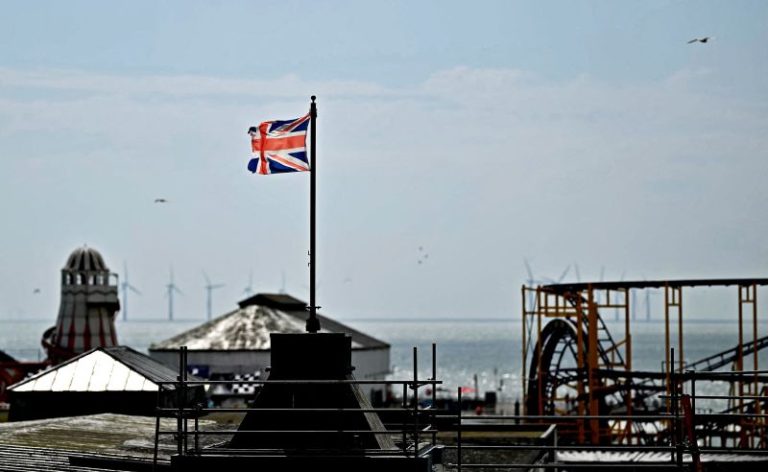US President Donald Trump has gone all in with his effort to strongarm Kyiv into peace negotiations with Russia, suspending US military aid to Ukraine with immediate effect.
The move has sent shockwaves through the Western world and left Ukraine and its allies scrambling.
Zelensky indicated on Tuesday that he was willing to go that way, saying Ukraine was “ready to come to the negotiating table” and that “my team and I stand ready to work under President Trump’s strong leadership to get a peace that lasts.”
Here’s what we know.
Trump’s order will have a direct impact on Ukraine’s ability to defend itself against Russia’s unprovoked aggression.
“Is it critical? Yes,” he said, pointing to Ukraine’s persistent weapons and ammunition shortages. Kyiv has been outgunned and outmanned by its much bigger neighbor since the opening salvos of Russia’s full-scale invasion, and the situation has become worse whenever Western deliveries have dwindled.
“Having in mind the shortage of ammunition and weapons, even 1% is critical. Thirty percent is definitely critical. Is it tragic? What we are hearing from different sources, Ukraine will be able to sustain this level or about the same level of violence density for about six months,” Melnyk said.
“It will have significant consequences, but the Russians are not likely to break through immediately or in the coming months,” said Kateryna Stepanenko, the Russia deputy team lead and analyst at the Institute for the Study of War, a US-based conflict monitor.
“The Ukrainians will be able to hold a defense, as we had seen them do in the past during the previous problems with aid,” she added, pointing to last year when deliveries from the US slowed down as Congress stalled on the next aid package.
“As a result, some of the effects could be felt almost immediately on the front lines. The Ukrainians will have to ration their use of certain munitions and that could spell trouble for their efforts to hold on to places like Pokrovsk,” he said.
An important logistics hub, Pokrovsk has been the prime target of Russia’s offensive in eastern Ukraine since the summer. Despite expectations that the city could fall within weeks, Kyiv’s forces have managed to hold Russian troops at bay – in part thanks to the steady deliveries of US military aid.
Trump is trying to force Ukraine into negotiating a peace deal with Russia without committing to providing security guarantees for Ukraine.
Zelensky has tried to make the case that a deal without guarantees would be potentially disastrous for Ukraine, arguing that Putin has violated ceasefire agreements in the past.
The Ukrainian leader has received near-universal backing from Kyiv’s Western allies on this point. British Prime Minister Keir Starmer told the UK Parliament on Monday that security guarantees must be part of any peace agreement.
“We know (Putin) is not a man to keep his word. We must be vigilant on all fronts in relation to Putin,” Starmer said.
Melnyk said that Ukraine had spent the past few weeks trying to understand which of Trump’s statements should be treated as policy announcements and which were just part of a strategy of trying to please the Russians and lure them into negotiations.
“With every practical step, there is more clarity that this is exactly what President Trump and his people are going to do (as policy). And currently, it’s not going to benefit anyone except our enemies and rivals like Russia and China,” he said.
He said the announcement on Monday sparked shock and sadness across Ukraine.
“Most Ukrainians simply glorify the United States of America and are being very sincere when saying ’God Bless America,’” he said. “This is a kind of real cold shower and probably one of the biggest shocks of the war.”
While Trump has not come out with a specific peace plan, he has suggested Ukraine will have to make sacrifices in terms of its territory, often repeating key Kremlin falsehoods and even suggesting that Ukraine “may be Russian someday.”
To many, this sounds like a capitulation.
John Lough, the head of foreign policy at the New Eurasian Strategies Centre, said that Zelensky cannot accept such a proposal.
“I don’t really understand what (Zelensky) is supposed to telling the Americans. ‘I am going to give our territory, I am going to agree to whatever terms that you discuss to the Russians?’” he said.
“I mean, this is absolutely absurd. They can’t do that, and they won’t do that,” he added.
The US is Ukraine’s biggest single provider of military aid, but not its only one.
According to the Kiel Institute, which monitors aid to Ukraine, the military aid that has been coming from Europe is comparable to that from the US and in the short term, the Europeans could step in and help Kyiv bridge the gap.
This has happened before – Europe’s aid became much more crucial during the first half of last year when US aid deliveries dwindled.
At the same time, Ukraine has become more self-reliant since the start of the full-scale invasion in February 2022.
“Ukrainians have significantly ramped up their production of drones, of their artillery, of their own personnel carriers. They’ve been doing that since 2023 since facing the possibility of not having aid,” Stepanenko said.
The European Union on Tuesday unveiled a plan to allow member states to borrow €150 billion ($158 billion) to boost their defense spending and “massively step up” their military support for Kyiv. The EU used a similar approach to raise funds to deal with the Covid-19 pandemic.
Some of Ukraine’s European allies are pushing for Russia’s frozen assets to be seized and used to fund defense aid. For now, only proceeds from these assets are being used to prop up Ukraine’s defense.
But the hard truth is that even if Europe had the necessary funds, it will take years for the underfunded European defense sector to measure up to that of the US.
There are also some weapon systems that only the US can provide, including the Patriot defense systems which are capable of bringing down cruise missiles, hypersonic missiles, short-range ballistic missiles and aircraft.
“The US holds licensing to the systems themselves and the missiles for them, which makes it challenging for European countries to recreate them,” Stepanenko said. The Patriots play a crucial role in Ukraine’s air defenses, protecting millions of civilians living across the country.
While other Western systems can be effective against cruise missiles and drones, the Patriots offer unparalleled protection against advanced hypersonic and ballistic missiles. Russia has been using these missiles on a regular basis; it has increased their domestic production and begun procuring more from North Korea.
Stepanenko said that Ukraine’s best option is to focus on strengthening its coalition with Europe.
“Ukraine had already laid pretty good groundwork for that by forming several initiatives, for example, several European states formed ammunition initiatives, they formed drone initiatives, air defense initiatives, and I think this is the time to expand those,” she said.
“There’s also a significant discussion about the need to seize Russian frozen assets in Europe to help sponsor any procurement of weapons, not just from the US, but also globally,” she added, pointing to countries like South Korea, which has in the past sold the US ammunition that was later given to Ukraine.
Trump has made no secret that he views the current blow-up through an extremely personal lens, blaming it entirely on Zelensky.
Kurt Volker, a former US ambassador to NATO and former US special representative for Ukraine, said that if he were to advise Zelensky, he’d urge him to sign the deal on natural resources as soon as possible.
The deal was meant to be signed when Trump met Zelensky at the White House on Friday – during the meeting that spiraled out of control and ended prematurely when the Ukrainian leader was ordered to leave.
“This will align the US and Ukraine going forward and serve the interests of both countries,” Volker said.
Zelensky said on Tuesday that he was ready to sign the minerals deal “any time and in any convenient format.”
Writing on X, the Ukrainian president said it was “regrettable that his meeting with Trump “did not go the way it was supposed to be.”
He said Ukraine was “ready to come to the negotiating table,” adding that “my team and I stand ready to work under President Trump’s strong leadership to get a peace that lasts.”
But a leading Russia analyst and historian, Mark Geleotti, said that Zelensky and Ukraine might need to go “beyond the point of kind words” to repair the relationship.
The past few weeks have shown that the Trump administration is prepared to go on a rollercoaster ride to achieve what it wants – and that nobody can quite predict what will happen next.
Lough said that there still seem to be gaps in the administration policy on Ukraine – most notably in the way different officials view Putin. Secretary of State Marco Rubio said last month, after meeting with Russian officials, that it remained to be seen whether Russia was serious about wanting peace.
“How do you reconcile that with what Trump is saying? He is implying he’s got Putin on side, that Putin is ready to go, and (they are) going to get a peace deal quickly,” Lough said.
“President Trump is mercurial, to say the least, but I think from a Ukrainian perspective, you know, they can’t bank on the fact that he’s going to suddenly show mercy and switch on the aid again and perhaps put President (Vladimir) Putin under pressure. We don’t see any signs of that yet,” he added.
Trump has made several U-turns on Ukraine over the past few weeks, calling Zelensky a dictator one day only to deny having made that statement a few days later.
While White House officials have said Zelensky should come back once he is ready to talk about peace, it remains to be seen whether Zelensky’s willingness to sign the natural resources deal could turn the aid tap back on.
Geleotti is sceptical. “I think that the fundamental point is that, as far as Trump is concerned, Ukraine is a bought-and-paid-for vassal state and has to understand its place. So it’s not just a bit of flattery today. Its reassurance is that Ukraine now understands that it has to do whatever America tells it to do,” he said.
This post appeared first on cnn.com










